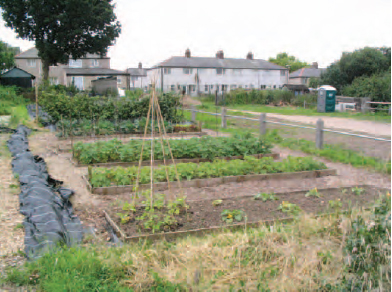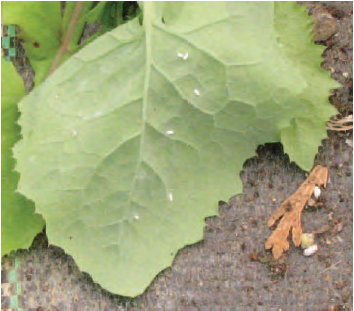Cultural control
ContentHorticulturists, in their everyday activities, may remove or reduce damaging organisms in many different ways and thus protect the crop. Below are described some of the more important methods used. Benefits: Fit in with daily routines. Have a long-lasting effect. Limitations: May be time-consuming. Cultivation Ploughing and rotavating of soils enables a physical improvement in soil structure as a preparation for the growing of crops. The improved drainage and tilth may reduce damping-off diseases, disturb annual and perennial weeds, such as chickweed and couch-grass, and expose soil pests, such as leatherjackets and cutworms, to the eager beaks of birds. Repeated rotavation may be necessary to deplete the underground rhizomes or tap roots of perennial weeds, such as couch-grass. Hoeing annual weeds is an effective method, provided the roots are fully exposed, and the soil dry enough to prevent root re-establishment. Soil fertility While the correct content and balance of major and minor nutrients (see Plant nutrition) in the soil are recognized as vitally important for optimum crop yield and quality, it should be remembered that plant resistance to pests and diseases is also affected by nutrient levels in the plant. Excessive nitrogen levels, causing soft tissue growth, encourage the increase of insects such as peach-potato aphid, fungi such as grey mould, and bacteria such as fireblight. Adequate levels of potassium, on the other hand, help control fungal diseases, such as Fusarium wilt on plants such as peas, tomatoes and carnation, and tomato mosaic virus. Fertility provided by composted material usually provides nutrients to the plant at the correct concentrations. Club root disease of brassicas is less damaging in soil with a pH greater than 6, and lime may be incorporated before planting these crops to achieve this aim. Amenity horticulturists apply mulches, such as composted bark, grass cuttings or straw, to bare soil in order to control annual weeds by excluding the source of light. Black polythene sheeting is used in soft fruit production to achieve a similar objective. Crop rotation Some important soil-borne pests and diseases attack specific crops, such as potato cyst nematode on potato and club root on cruciferous plants. As they are soil-borne, they are slow in their dispersal, but are difficult to control. By the simple method of planting a given crop in a different plot each season, such pests or diseases are excluded from their preferred host crop for a number of years, during which their numbers will slowly decline. A gardener often creates five or six plots (sometimes bounded by wooden planking) to achieve successful rotation. Plants belonging to the same plant families fit into the rotation system. They have the same sensitivity to particular pests and diseases. Potatoes, tomatoes, peppers and aubergines are all members of the Solanaceae. Melons, marrows, courgettes and cucumbers all belong to the Cucurbitaceae. When considering a rotation plan, it is advisable to confine members of the same family to the same plot in the same growing season. Rotation does not work well against unspecific problems, such as grey mould, which may attack a wide range of plant families. Rotation is also not likely to be effective against rapidly spreading organisms such as aphids.
Planting and harvesting times Some pests emerge from their overwintering stage at about the same time each year, such as cabbage root fly in late April. By planting early to establish tolerant brassica plants before the pest emerges a useful supplement to chemical control is achieved. The deliberate planting of early potato cultivars enables harvesting before the maturation of potato cyst nematode cysts, so that damage to the crop and the release of the nematode eggs is avoided. Annual weeds may be induced to germinate in a prepared seedbed by irrigation. After they have been controlled with a contact herbicide, such as paraquat, a crop may then be sown into the undisturbed bed or stale seedbed, with less chance of further weed germination. Clean seed and planting material Seed producers take stringent precautions to exclude weed seed contaminants and pests and diseases from their seed stocks. While weed seeds are, in the main, removed by mechanical separators, and insects can be killed by seed dressings, systemic fungal seed infections, such as celery leaf spot disease in celery seed, are best controlled by immersion of dry seed in a 0.2 per cent thiram solution at 30°C for 24 hours (thiram soak treatment). The seed is then re-dried. A similar treatment is often given for carrot and parsley seed. Equal care is taken to monitor seed crops likely to carry virus disease (such as tomato mosaic). Curative control by dry heat at 70°C for four days is usually effective, although it may reduce subsequent seed germination rates. Vegetative propagation material Vegetative propagation material is used in all areas of horticulture, such as bulbs (tulips and onions), tubers (dahlias and potatoes), runners (strawberries), cuttings (chrysanthemums and many trees and shrubs) and graft scions in trees. The increase of nematodes, viruses, fungi and bacteria by vegetative propagation is a particular problem, since the organisms are inside the plant tissues, and since the plant tissues are sensitive to any drastic control measures. Inspection of introduced material may greatly reduce the risk of this problem. Soft, puffy narcissus bulbs, chrysanthemum cuttings with an internal rot, whitefly or red spider mite on stock plants, virus on nursery stock, are all symptoms that would suggest either careful sorting, or rejection of the stocks. Accurate and rapid methods of virus testing (using test plants, electron microscopy and staining by ELISA techniques) now enable growers to learn quickly the quality of their planting stocks. Fungal levels in cuttings (such as Fusarium wilt of carnations) can be routinely checked by placing plant segments in sterile nutrient culture. The quality of vegetative material is monitored in the UK by the Plant Health Propagation Scheme. In particular, it supervises the provision of six quality levels of plant material (Foundation, Super Elite, Elite, A, Approved and Healthy grades) for the soft fruit, top fruit and bulb industries. Hygienic growing During the crop, the grower should aim to provide optimum conditions for growth. Water content of soil should be adequate for growth (see field capacity), but not so excessive that root diseases (such as damping off in pot plants, club root of cabbage and brown root rot of conifers) are actively encouraged. Water sources can be analyzed for Pythium and Phytophthora species if damping off diseases are a constant problem. Covering and regular cleaning of water tanks to prevent the breeding of these fungi in rotting organic matter may be important in their control. Seed trays and pots should be washed to remove all traces of compost that might harbour damping off disease. Conifer nursery stock grown on raised gravel beds is less likely to suffer the water-borne spread of conifer brown rot. Many protected crops are grown in isolated beds or peat modules to reduce spread of wilt-inducing organisms (such as Fusarium spp.). Gooseberry sawfly caterpillars can be removed in spring from leaves found on the lower centre stems of the gooseberry. This action helps prevent subsequent invasions by the pest in the summer months. High humidity encourages many diseases. In greenhouses, the careful timing of daily overhead irrigation and of ventilation (to reduce overnight condensation on leaves or flowers) may greatly reduce levels of diseases, such as grey mould on pot plants or downy mildew on lettuce. The slow drawing-back of motorized thermal screens high above commercial glasshouse crops (so as to prevent condensation problems) has contributed greatly to the reduction of disease.
Reducing spread of pests and diseases The spread of pests and diseases from plant to plant or field to field can be slowed down. Tomato mosaic virus spread may be reduced by leaving suspect plants till the end of de-leafing or harvesting. Washing knives and hands regularly in warm, soapy water will reduce subsequent viral spread. Soil-borne problems, such as club root, eelworms and damping off diseases, are easily carried by boots and tractor wheels. Foot and wheel dips, containing a general chemical sterilant, such as formaldehyde, have been successfully used, especially in preventing damping off problems in greenhouses. Alternate hosts Alternate hosts harbouring pests and diseases should be removed where possible. A few examples of many alternate hosts are given here. Soil-borne problems, such as club root of cabbage and freeliving eelworms on strawberries are harboured by shepherd’s purse (Capsella bursa-pastoris) and chickweed (Stellaria media) respectively. Groundsel (Senecio vulgaris) is an alternate host of rust on cinerarias, while docks (Rumex spp.) act as a reservoir of dock sawfly, which damages young apple trees. Removal of infected plant material With rapid-increase problems, such as peach-potato aphid and white rust of chrysanthemum fungus in greenhouses, removal of affected leaves is practicable in the early stages of the problem, but becomes progressively unmanageable after the pest or disease has increased and dispersed throughout the plants. Slow-increase problems, such as Fusarium wilt disease on tomatoes or carnations and vine weevil larvae found damaging roots of plants such as primulas and begonias, may be removed throughout the crop cycle, but the infected roots and soil must be carefully placed in a bag to prevent dispersal of the problem. In commercial outdoor production, labour costs usually prevent such removal during the growing season. However, removal is achieved chemically in some situations. The destruction of blight-infected potato foliage with herbicide such as diquat prior to harvest reduces infection of the tubers. Burning of post-harvest leaf material and lifting of root debris after harvest (against grey mould on strawberries and club root on brassicas respectively) may help prevent problems in the next crop. In fruit tree species such as apple, routine pruning operations may remove serious pests such as fruit tree red spider mite, and diseases such as canker and powdery mildew. Pruning should also aim to reduce the density of shoots in the centre of the tree. The reduction in humidity provides a microenvironment less favourable to disease increase. Tree stumps harbouring serious underground diseases such as honey fungus should be removed manually or using a mechanical stump grinder. Making a feature of an infected stump by placing a bird table on it is one of the least recommended activities in gardening. Safe practice In physical/cultural control, some hazards are:
|






